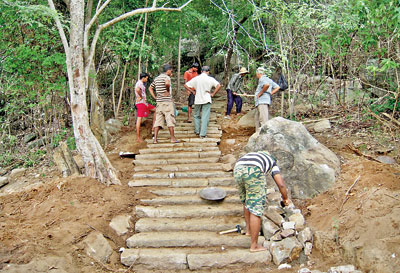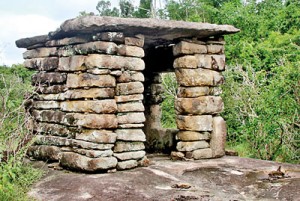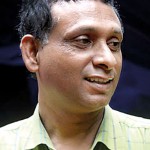Multi-faceted findings on a mountain
View(s):In this second part of the article on Rajagala, Duvindi Illankoon and Vinusha Paulraj talk to the key people behind the excavations and conservation of this historical site
Sheets of blue polythene suspended ad hoc give the ancient stupa added cover under the thick protection of forest growth. A splash of water from a bucket dispels the fine layer of earth that has kept the paving around its base hidden, almost instantly revealing faint carvings of symbols. For the team of archaeologists at Rajagala, it’s fairly ordinary business but for us, it’s slightly magical.

Mountain with hidden secrets: The team at an excavation site

Prof. P.B. Mandawala
Ever since its discovery in the 1890’s by the Department of Archaeology, this little known of corner of Ampara has been revisited time and again by different teams intent on unearthing its history. A monastery built into a mountain forest spanning 1025 acres, Rajagala is believed to be over 2100 years old.
Over the last century some of the country’s most brilliant minds including Dr. Senarath Paranavithana have made their attempts to unravel its mystery. Based on inscriptions and mentions in the Mahavamsa, it is known that the monastery was built by Prince Lajjatissa, son of King Saddhatissa during the 1st century BC. Of its eventual decline not much is recorded, but it is assumed that the monastery’s inhabitants were driven away by the Chola regime which heralded the end of the Anuradhapura era. Today its exploration has become the task of a team from the University of Sri Jayewardenepura, joined by members of the Department of Archaeology.

The abode for monks that was mistaken for an LTTE bunker when first sighted in 2009. Pix by Indika Handuwala
Prof. P.B. Mandawala currently oversees the project along with Prof. P. Kannangara, Prof. Karunasena Hettiarachchi and Dr. K. M. Alexander. Progress has been an effort, he tells us, owing largely to the pace at which funding is trickling in. Joint lobbying by the

Dr.K.M. Alexander
Department of Archaeology and the university, together with financial assistance from the US Ambassador’s Fund for Cultural Preservation has enabled them to complete conservation work in one sixth of the area. Currently in the process of putting together proposals to the Cabinet and other cultural grants Prof. Mandawala and his team say the initial cost estimates of the project totals Rs.300 million.
However the Rajagala Tank has been restored speedily, largely owing to the efforts of former Vice Chancellor of the University of Sri Jayewardenepura, Dr. N. L. A. Karunaratne. His commitment to conserving the tank saw Dr. Karunaratne even play the role of site-supervisor in September this year, ensuring the tank’s completion-ready for the monsoon-in just over a month.
Excavations in the rest of the monastery have revealed about 700 artefacts so far. Initial investigations have been conducted in about 600 acres of the total area and they expect to unearth many more artefacts during their project, which began in 2012 and which is due to end in 2019.
Part of the fascination for Prof. Mandawala is the fact that “there are a variety of artefacts found here.” Even the caves are different: some have built-in seats while others are mere crevices in the rock, with enough space to house just one. The vast expanse of the mountain leaves the team only able to speculate as to what their next find would be. He feels it’s only by visiting the site can one gather for themselves the potential it has.
Indeed, wandering around the site is testament to the multifaceted finds. Ruins of stupas, statues and murals are attested to by stone inscriptions. The danashala (dining halls) and hydraulic systems of the common areas reveal a certain institutionalised structure that must have been present among the monks at Rajagala. Yet the caves reveal a hermit-like living style that sits at odds with the structures below. “It is rare to find monks living this type of life-style,” says Prof. Mandawala. While most other ruins around the country testify to having been a hermitage or an orthodox monastery as is the case in Ritigala, a combination of both, he feels, is a significant find.

Prof. P. Kannangara
One such discovery lies at the top of a small hill on the descent from the mountain. A simple abode built of stone blocks balanced on each other, to protect a meditating monk from the elements, this structure is believed to be about 1500 years old. In 2009, when a team from the Department of Archaeology were exploring the mountain to find a pathway for vehicles, they saw the hut from a distance and assumed it was an LTTE bunker. The mountain was believed to have been occasionally inhabited by the insurgents during the years of the conflict. “We even went up with an army escort who carried a gun!” they recall.
Upon closer inspection of the ruins, they found deep cracks on artefacts, ransacked caves and crumbled bricks from the impact of explosives, the damage suffered at the hands of treasure hunters.
The team though has been extra careful not to disturb the site. A stone stairway has been constructed to cover part of the ascent, and every single block was brought in from the village and lugged up by the team. “We didn’t want to move anything around within the monastery,” says Gayan Priyantha, a graduate of the university who acts as a guide for visiting parties.
The villagers who reside below the mountain and around it have also been integrated into the excavation process. Ninety labourers assist in the excavation, and these villagers have also been entrusted with the task of protecting the monastery’s heritage. They are the ones who report sightings of treasure hunters, which has led to the establishment of a police post for the site.
Future plans also include the establishment of a multimedia centre at Rajagala. Their meticulous records show that during May this year the site had 3000 visitors- a peak which they believe is due to the religious significance of the site. The multimedia centre will present introductory videos for visitors about the unique finds unearthed at Rajagala, offering them a glimpse into the mountain’s heritage before they make their ascent.
| Visit this treasure trove of a site The first 500 metres or so, leading up to the caves is the more relaxed part of the climb. Conservation efforts have resulted in stairs that ease you into the steep climb. The rest of the trek however, will require two free hands and buckets of energy. Since much of the journey involves jumping over boulders, squeezing through caves and forging through forest growth, a pair of trusty shoes is a smart option- any covered pair, even running shoes would do. You won’t regret taking a camera. The view from some parts of the site is definitely one for the books. Bringing your phone would be advisable-much of the site has reception, which means you are still connected to civilization in case of an emergency. The hike is not one that can be made in denim jeans. While there isn’t a specified dress code as in certain other religious archaeological sites in the country, it does help to keep in mind that this too is steeped in religious history. Visitors are only allowed up from 8 a.m. – 3 p.m. If need be, one of the team members on the site could accompany and direct your visit- for more information call Gayan Priyantha on 0113167977. |


